Types of Hornbeam Trees With Pictures and Identification (European, American, Columnar)
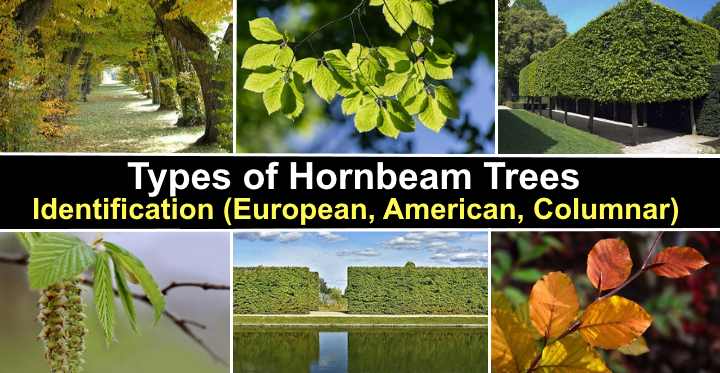
Hornbeam trees are a group of deciduous, flowering hardwood trees in the genus Carpinus. Hornbeams are ornamental landscape trees with a wide canopy, dark green, ovate leaves with serrated margins, and slim clusters of yellowish flowers. Common species of hornbeam trees—the American hornbeam (Carpinus caroliniana) and European Hornbeam (Carpinus betulus)—are popular in home garden landscapes and parks.
This article is a comprehensive guide to the most popular types of hornbeam trees. Descriptions and pictures of these attractive landscaping trees will help to identify them. You will also discover if a hornbeam tree is suitable for your garden as an elegant shade tree.
Hornbeam Tree Facts
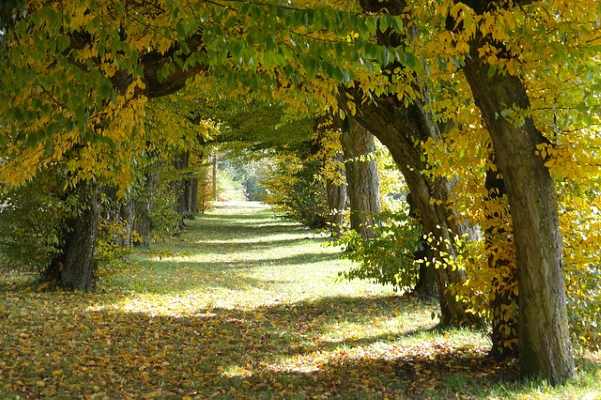
Hornbeams are deciduous trees with wide canopy and autumn foliage in shades of yellow, orange or red
Hornbeam trees are related to birch trees in the family Betulaceae. There are 41 species of hornbeam trees, with one native to North America (Carpinus caroliniana) and one native to Europe (Carpinus betulus). Native hornbeam trees are classified as small to medium-sized trees growing between 20 and 82 ft. (6 – 25 m).
The most popular hornbeam cultivar is the ‘Fastigiata’ European Hornbeam (Carpinus betulus ‘Fastigiata’). This columnar landscape tree has a pyramidal shape and dense canopy, making it ideal for growing as a hedge plant, privacy screen, or natural fence.
The hornbeam tree is a deciduous tree with a dense oval or vase-shaped crown. Its attractive silhouette is easily recognizable in the landscape with its short, twisted trunk. The thick canopy consists of ovate leaves with toothed margins. The hornbeam tree flowers are yellow catkins—drooping slender flower clusters that develop into papery winged fruits.
Hornbeam trees are described as monoecious deciduous trees. This means that a single tree produces male and female flowers on separate catkins. The hornbeam tree propagates through wind dispersal from a small fruit (nut) growing in a winged papery bract. Each catkin has between 10 and 30 seeds.
The common name of trees in the Carpinus genus—hornbeam—describes the tree’s properties and hardness of the wood. For example, the hornbeam timber is as hard as “horn,” and “beam” is an Old English name for a tree.
Hornbeam trees thrive in full sun or partial shade and grow in most types of soils, as long as they are well-drained. The hardy American hornbeam trees grow well in USDA zones 3 through 9. The European hornbeam is winter hardy in zones 4 to 7.
Hornbeam trees have relatively slow growth and have an average growth rate of 12” (30 cm) per year. Growing for between 50 and 150 years, the American hornbeam tree reaches an average mature height of 20 to 30 ft. (6 – 10 m). The European hornbeam has an average height of 40 to 60 ft. (12 – 20 m).
Hornbeam Bark
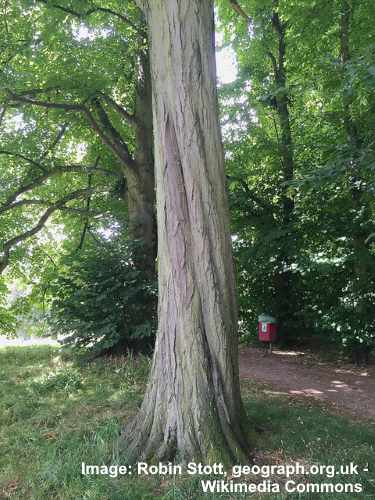
European hornbeam (Carpinus betulus) bark
Hornbeam trees have identifiable smooth gray or blue-gray bark that develops distinctive fluted furrows and ridges with age. The characteristic bark on hornbeam trees is relatively thin and damages easily. Immature hornbeam tree bark is grayish-brown without furrows.
Hornbeam Leaves
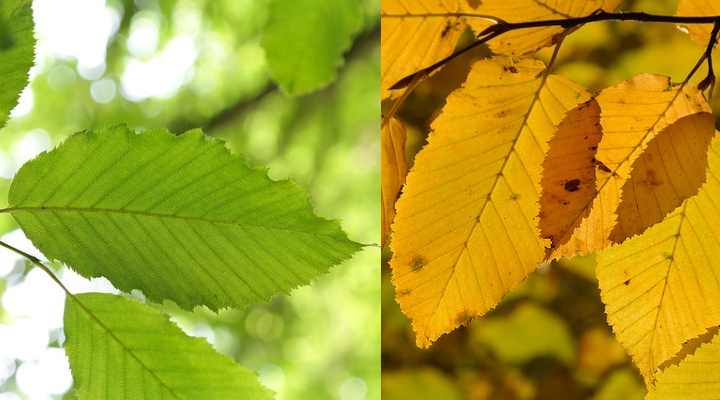
Hornbeam leaves
Hornbeam tree leaves are bright to dark green, ovate shaped, with sharply serrated margins and a toothed apex. The hornbeam leaves have deep veining, giving the pointed leaves a quilted or pleated appearance. The hornbeam tree’s distinctive leaves turn shades of yellow, orange, or red in the fall. The leaves measure 2” to 4” (5 – 10 cm).
Hornbeam Flowers
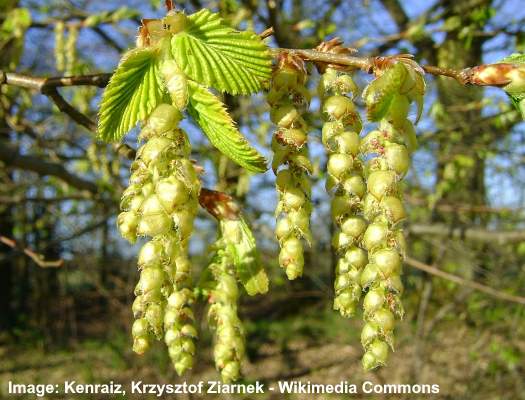
European hornbeam (Carpinus betulus) flowers
Hornbeam tree flowers are drooping slender catkins that have a yellowish-green color. The slim, cylindrical flower clusters appear in spring but don’t have any unique characteristics. The yellow female catkins measure 3″ – 4” (7.5 – 10 cm) long, and the male flowers measure 1.5” (3.8 cm) long.
Hornbeam Fruit
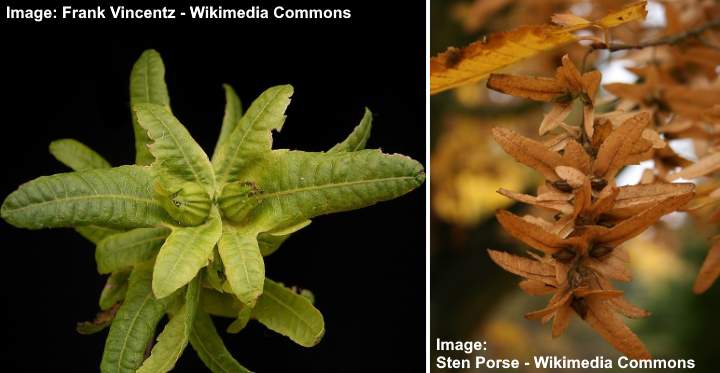
European hornbeam (Carpinus betulus) fruit – immature (left) and mature fruit (right)
Hornbeam tree fruit is a small, oval brown nutlet that measures 0.5” (1.2 cm) in diameter. The hornbeam nut is held in a papery serrated enclosure called a samara. The brown hornbeam fruits appear in the fall and sometimes persist on the tree throughout winter. The fruits attract small mammals and birds.
How to Identify Hornbeam Tree
A hornbeam tree is easy to identify in the landscape. It has a short, twisted trunk with spreading crooked branches forming a dense vase-shaped or oval canopy. Hornbeams have distinctive blue-gray bark and identifiable ovate leaves with a pleated appearance, drooping yellowish catkins, and brown papery samaras. The hornbeam tree turns golden yellow in the fall.
Common Types of Hornbeam Trees
- European Hornbeam (Carpinus betulus)—The medium-sized deciduous tree grows 40 to 60 ft. (12 – 20 m) tall. It has distinctive dark-green ovate leaves with pronounced deep veining and serration growing alternately on branches. The European hornbeam is identified by its dense oval or vase-shaped spreading crown.
- Columnar European Hornbeam or ‘Fastigiata’ (Carpinus betulus ‘Columnaris’)—The popular hornbeam has a distinctive pyramidal crown. The narrow, columnar crown is formed by densely growing ovate or oblong leaves with double serration. This columnar deciduous tree grows 30 to 40 ft. (9 – 12 m) tall and 15 to 20 ft. (4.5 – 6 m) wide.
- American Hornbeam (Carpinus caroliniana)—This small deciduous tree is identified by its symmetrical vase-shaped canopy and dense foliage. The American hornbeam has oblong or egg-shaped leaves with double serrated edges and prominent veins. The tree grows 20 to 30 ft. (4.5 – 9 m) tall and wide.
Hornbeam Hedge
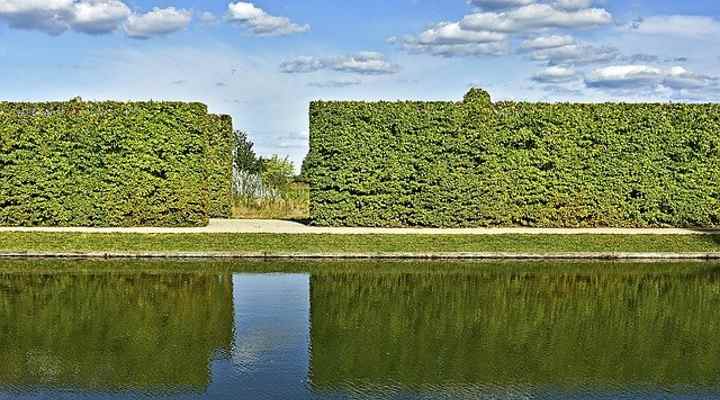
Hornbeam hedge
The European hornbeam ‘Fastigiata’ has ideal growth characteristics as an attractive and functional hedge. Due to its dense foliage, compact growth, and close branching, the columnar European hornbeam tree is easy to prune into a privacy screen or impenetrable hedge.
The deciduous European hornbeam ‘Fastigiata’ is an excellent hedge tree that is tolerant of poor growing conditions, including drought, wet soils, and high winds. Additionally, with regular pruning, the shrub-like tree is easy to maintain as a deciduous hedge between 3 and 16 ft. (1 – 5 m).
Hornbeam trees have similar characteristics as beech trees for growing as a hedge.
Types of Hornbeam Trees (with Pictures) – Identification Guide
Let’s look in more detail at the identifying features of three of the most common hornbeam trees.
European Hornbeam (Carpinus betulus)
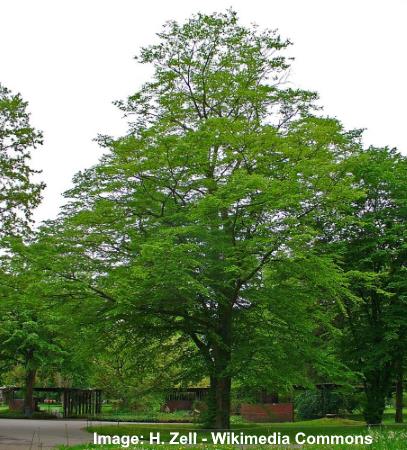
European hornbeam (Carpinus betulus)
The European hornbeam is an ornamental landscape tree with beech tree-like characteristics. The hornbeam tree is identified by its rounded, vase-shaped crown, densely growing dark green leaves, and golden yellow, slender cylindrical flowers that appear in April or May. European hornbeam trees grow 40 to 60 ft. (12 – 18 m) tall and 30 – 40 ft. (9 – 12 m) wide.
European hornbeam trees have a pyramidal shape when young. The slow-growing hornbeam tree grows around 10 ft. (3 m) in ten years. In time, the dense canopy becomes more rounded with an oval shape and irregular silhouette. The robust, hardy hornbeam trees have a lifespan of up to 300 years.
The European hornbeam thrives in USDA zones 4 through 8. The tree performs best in part shade or full sun and can grow in clay or loam soils. One growth habit that makes the tree popular is that it is drought-resistant but can occasionally withstand wet conditions.
A distinctive feature of European hornbeams is their ovate-shaped leaves. The dark green pointed leaves have a smooth, hairless surface. However, the blades are doubly serrated, giving them a ridged or quilted appearance. The hornbeam leaves look like beech tree leaves and measure 2” – 4” (5 – 10 cm) long.
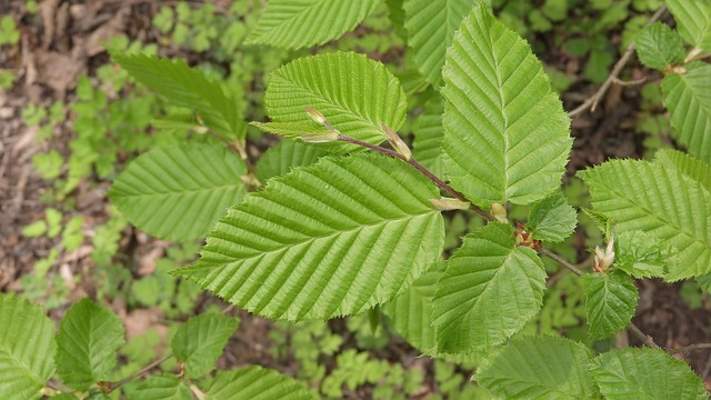
European hornbeam (Carpinus betulus) leaves
The European hornbeam tree’s botanical name betulus means beech-like.
In spring, yellow drooping catkins appear on the tree on bare branches. The inconspicuous flowers measure between 1.5” and 3” (3.8 – 7.5 cm) long, depending on if they are male or female flowers. After blooming, fruit in the form of hard nuts in papery casings develop.
Hornbeam trees are not considered messy trees because the fruit persists on the tree until winter.
The bark on European hornbeam trees is characteristically light gray with a beautiful, fluted appearance. The smooth gray bark has rounded furrows growing on a relatively short trunk. The unusual appearance of the bark makes hornbeam trees easy to identify in the winter landscape.
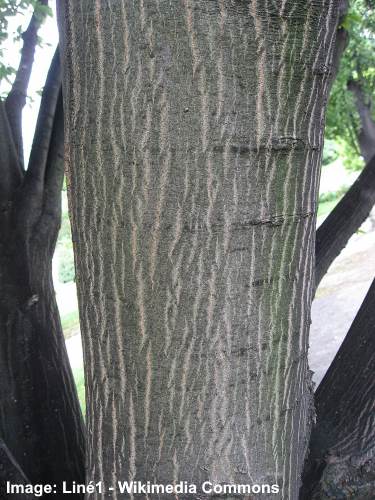
European hornbeam (Carpinus betulus) bark
Hornbeam trees, including Carpinus betulus, are famous for their heavy hardwood. This characteristic means the timber is prized for making durable tools, pianos, and constructions. Additionally, the chopped hornbeam wood is ideal as firewood as it burns for a long time.
The tree’s slow growth habit, hard wood, closely growing branches, and dense foliage make the tree popular in landscape gardening, especially as a tall hedge or topiary.
European Hornbeam Leaves: The hornbeam tree leaves have an identifiable ovate shape with double serration and prominent deep veins. The leaves are dark green, and they turn golden yellow in the fall before they drop.
European Hornbeam Bark: The hornbeam tree bark is smooth and gray when immature and gradually develops fluted furrows as the tree matures.
Columnar European Hornbeam or ‘Fastigiata’ (Carpinus betulus ‘Columnaris’)
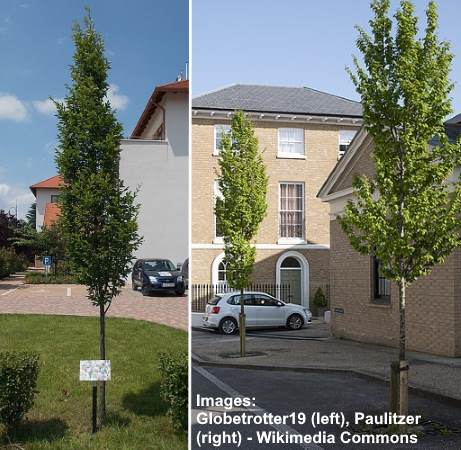
Columnar european hornbeam
The Columnar European hornbeam is a pyramidal tree, identified by its short trunk, low branches, densely growing dark green foliage, and columnar habit. The ‘Fastigiata’ hornbeam grows 30 to 40 ft. (9 – 12 m) tall with a narrow habit of 15 to 20 ft. (4.5 – 6 m) wide.
The tall skinny columnar European hornbeam tree has simple leaves with double serrated margins. Serration and deep veins on the ovate-shaped dark green blades give the leaves a ridged appearance. The dense canopy makes the columnar tree an ideal hedge plant.
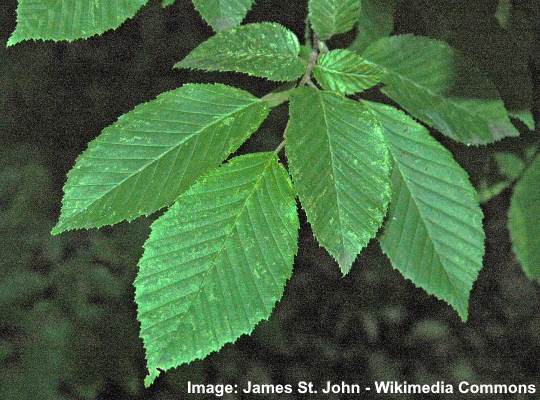
Columnar European hornbeam leaves
As with all hornbeam trees, the columnar European hornbeam has naturally strong branches. This characteristic means that little pruning is required to develop a strong structure. The only pruning required is for maintaining the trees’ height and shape when growing in a row as a privacy screen.
Also called the pyramidal European hornbeam, the columnar hornbeam tree has smooth, light gray bark with brown patches. As the skinny tree matures, the bark becomes slightly furrowed like the Carpinus betulus.
When in bloom in late spring, the columnar hornbeam tree produces catkins of whitish flowers. These inconspicuous flowers droop from the ends of upward growing branches. After blooming, hornbeam fruit develops. The small hard, brown nuts are encased in a papery winged enclosure waiting for the wind to distribute them.
If you are looking for a dwarf hornbeam tree for a compact garden, choose the European hornbeam Carpinus betulus ‘Columnaris Nana.’ This short columnar tree grows 6 to 8 ft. (1.8 – 2.4 m) tall and 3 to 4 ft. (1 – 1.2 m) wide. The slow-growing conical tree with dense dark green foliage turns a stunning yellow in the fall.
Columnar European Hornbeam Leaves: The distinctive leaf shape of the pyramidal hornbeam tree makes it easy to identify. The jagged-looking dark green leaves grow 2” to 4” (5 – 10 cm) long. In the fall, the hornbeam ‘Fastigiata’ foliage turns a showy bright yellow color.
Columnar European Hornbeam Bark: The pyramidal European hornbeam bark is smooth and gray with a distinctive fluted texture.
American Hornbeam (Carpinus caroliniana)
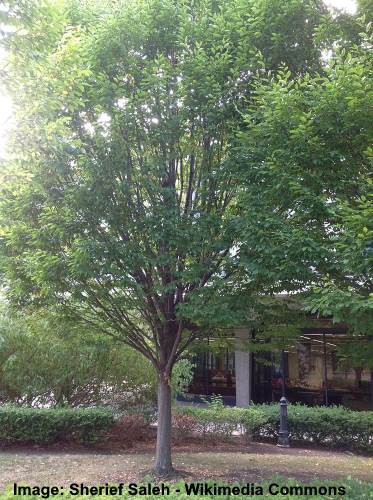
American hornbeam (Carpinus caroliniana) tree
The American hornbeam is a native small ornamental hardwood tree with mottled gray and white bark, doubly serrated leaves, and pendulous golden-yellow catkins. In a landscape, the hornbeam tree is identified by its pyramidal or vase-shaped canopy and dense growth. American hornbeams grow 20 to 40 ft. (6 – 12 m) and up to 30 ft. (9 m) wide.
The American hornbeam tree grows as a multi-stemmed shrub-like tree or a single-stemmed specimen tree. The small, slow-growing landscaping tree grows well in the shade in naturalized woodlands. However, in its native habitat, the tree grows as an understory tree in deciduous forests.
Compared to the European hornbeam, the American hornbeam tree has a narrower and more upright growth habit. In addition, the Carpinus caroliniana is hardier in colder climates, and its growing range is in USDA zones 3 through 9. Also, unlike other hornbeam trees, the American hornbeam thrives in full shade.
The American hornbeam has bluish-gray bark. Due to its resemblance to beech trees, the tree also goes by the name blue beech. Other common names for the tree include musclewood or ironwood due to the strength of its wood. It also has the name water beech because it often grows next to rivers and streams.
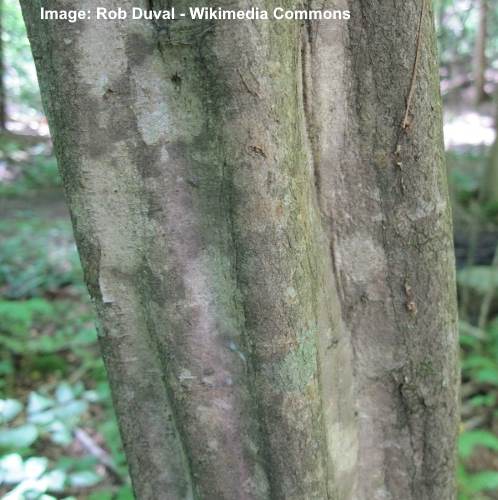
American hornbeam (Carpinus caroliniana) bark
American hornbeam flowers are dangling catkins that are green and orange or reddish-brown color that bloom from April. The pendulous tubular flowers are not particularly showy. However, after blooming, clusters of hornbeam fruit appear. These small oval nuts look like hops hanging from branches.
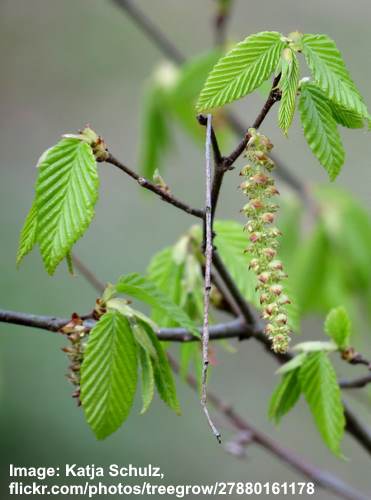
American hornbeam (Carpinus caroliniana) flowers
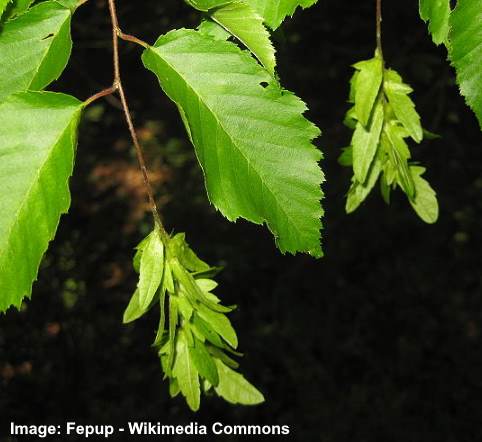
American hornbeam (Carpinus caroliniana) immature fruit
Like many types of hornbeams, this species has a short trunk and a low branching habit. Its upward growing, narrow silhouette with its crooked trunk and pendulous, zig-zagging branches create an attractive visual accent in a garden landscape. Additionally, the hornbeam tree is ideal for growing near a patio or deck area as a beautiful shade tree.
American Hornbeam Leaves: The leaves on Carpinus caroliniana are ovate or lance-shaped leaves with doubly serrated edges, deep veins, and a ridged patterned look. The simple leaves grow alternately on branches and are 2” to 5” (5 – 13 cm) long. In the fall, the American hornbeam leaves turn warm shades of oranges, reds, or yellows.
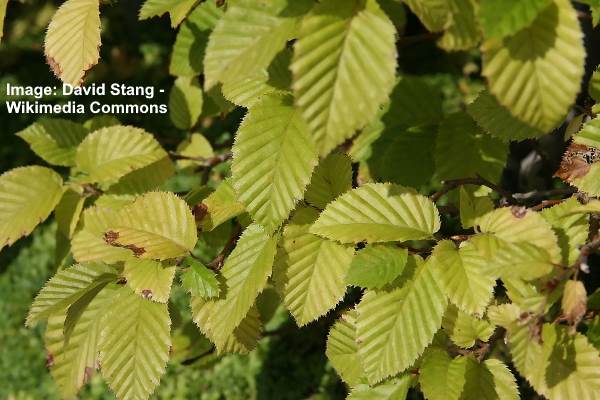
American hornbeam (Carpinus caroliniana) leaves
American Hornbeam Bark: This hornbeam is characterized by bluish-gray bark that has a “muscular” look. In time, the smooth bark becomes slightly rougher with loose scaly plates.
American Hop-Hornbeam (Ostrya virginiana)
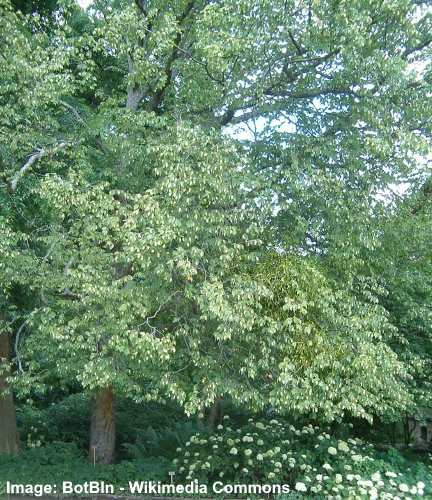
American Hop-Hornbeam (Ostrya virginiana)
The American hop-hornbeam has a similar common name as trees in the genus Carpinus. Although it is also related to beech trees, it’s a different genus from traditional hornbeams.
The American hop-hornbeam is a small, slender deciduous tree with birch-like serrated leaves, shaggy light brown to dark brown bark, and clusters of golden yellow hop-like catkins. The American hop-hornbeam has a spreading oval or round canopy with a smooth outline. This tree grows 20 to 40 ft. (6 – 12 m) tall and up to 30 ft. (9 m) wide.
The tree’s name comes from its catkins that look like dangling hops on the ends of branches. Other common names for the tree include eastern hop-hornbeam, leverwood, or woolly hop-hornbeam.
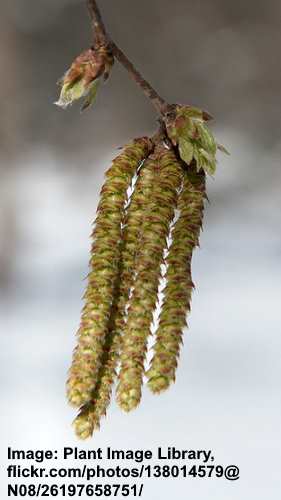
American Hop-Hornbeam (Ostrya virginiana) flowers
The Ostrya virginiana leaves have doubly serrated margins and a lanceolate or ovate shape. The sharply serrated, yellowish-green leaves grow up to 4” to 8” (10 – 20 cm) long. This slow-growing tree has leaves like birch tree leaves.
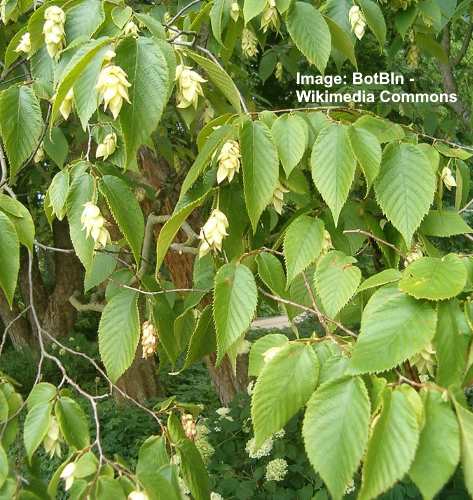
American Hop-Hornbeam (Ostrya virginiana) leaves
The distinctive bark of the American hop-hornbeam is reddish brown-gray and tends to split into narrow strips that peel off the trunk.
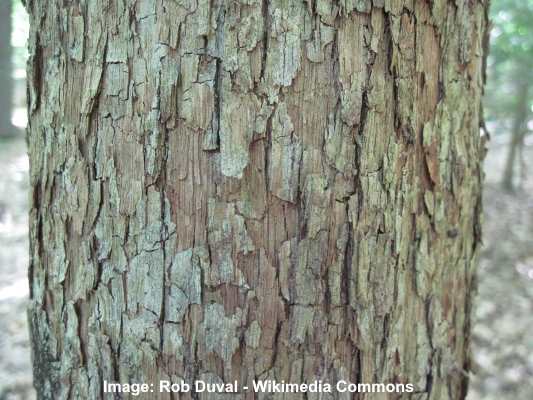
American Hop-Hornbeam (Ostrya virginiana) bark
The growth habit of the American hop-hornbeam makes it challenging to distinguish from elm trees. The way to tell hop-hornbeam trees apart from elm trees is that their leaves don’t have an asymmetrical base like elm leaves.
Related articles:
